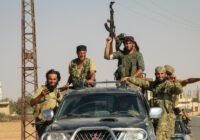Will new tactics by terrorist organizations bring an influx of attacks in 2016?
The Islamic State’s (IS) so-called caliphate is being shrunk by the Russians and Syrians in northwestern Syria. On January 26, the Syrian army captured the key location of Sheikh Maskin, which lies on a key crossroads with Damascus to the north and the government-controlled city of Sweida to the east. In the east of IS territory, Peshmerga forces from the autonomous area of Iraqi Kurdistan not only hold their own, but also push the Islamic State back. In the southwest, the fall of Ramadi to the Iraqi army and Iranian-backed militia in December 2015 was a severe blow to the terrorist organization.
Together, all parties involved have contributed to IS losing large portions of its previously held territory at the beginning of 2016.
The latter part of 2015 saw the Russian and US-led coalition airstrikes target oil locations, vehicles carrying oil and the Islamic State’s main bank, costing the group millions of dollars. So much so that there were reports that its fighters were taking pay cuts as money became scarcer.
In Syria and Iraq, the various forces fighting the terrorist organization will have to ensure that the successes in 2015 will be built on in 2016. What will still be in place is a huge propaganda machine capable of turning quiet, innocent people into murderers on its behalf. Like any group, IS will at some point have to fight back as it finds itself losing ground, having its back against a wall. It will lack the funds, fighters and equipment to retaliate.
With individuals and groups outside of Syria and Iraq claiming allegiance to IS, some have allegedly secured recent successes for the organization by taking terrorism to the streets. It will not be difficult for IS to organize and create chaos in summer tourism spots or around Europe.
People have already seen the consequences of the horrific Tunisian attack on its tourism industry, populated shopping malls being targeted in Kenya and Somalia, and innocent people enjoying a night out in Paris. The Islamic State will strike at any soft target that is available.
In January, French police admitted that they had thwarted another Paris strike. French Interior Minister Bernard Cazeneuve pointed out that since spring 2015, French intelligence services had foiled 11 terrorist attacks that had been planned by IS—those of which were prior to the November 2015 Paris attack. Since that incident, French authorities have placed the country in a “state of emergency” and have declared that it will remain in place until the Islamic State is defeated.
So far in 2016
The year 2016 started well for international terrorists when the Pakistani Taliban attacked Bacha Khan University in northwest Pakistan on January 20, killing 30 people and injuring dozens more.
A day later, al-Shabab attacked a beachside restaurant-hotel in Somalia’s capital of Mogadishu, resulting in approximately 20 people losing their lives. Al-Shabab had pledged its allegiance to IS in October 2015, having once been allied with al-Qaeda. The interesting point regarding this assault was that it was a two-pronged offensive: Suicide bombers struck the front of the restaurant, while a sea-borne assault raided those on the beach.
This style would allow for very few people to escape. There were even reports of white people being checked to see if they were dead. This was probably in response to the French government and others issuing a guide as to what to do in the event of a terrorist attack.
Al-Shabab claimed responsibility for the incursion and claimed that its militants wore suicide vests. Suicide vests are one of the latest and new additions to a terrorist’s method of attack. The first time the vests were used was during the Paris attack in November 2015.
STRATEGIC TARGETS AND TACTICS
Terrorists are learning from each coordinated attack and, with it, the capability to strike, organize and cause death and chaos with slightly different tactics. Like any military-style operation, there will be people who look at the procedure and see where they can improve. It is interesting to note that after the 2008 Mumbai attack, al-Shabab raided a shopping mall in Nairobi, Kenya, in what appeared to be a similar operation.
In January 2016, Europol published a press release regarding IS changing its modus operandi. The paper gave no indication over the change in tactics, but did say that IS has a special forces-style group that would be used in future terrorist attacks it conducts, outside of IS territory.
If the Islamic State attempts to “set Europe alight” with acts of terrorism, what would the targets be?
In recent years, terrorist organizations have started favoring the Mumbai-style assaults, where small groups of gunmen attack a soft location and kill as many people as they possibly can. This type of attack gives the terrorist group huge media and press coverage. With that, the world watches as the event unfolds, while various newsgroups search for exclusive shots or information.
Terrorists will also be following the live events and watching for ways to improve, as well as taking note as to how authorities respond. News staff attempting to analyze and preempt what is happening, what has happened and what the authorities are doing gives the terrorists some food for thought for their next attack.
Tourism and Refugees
Tourism may be a key target for 2016, especially around popular coastal holiday resorts since the successful Tunisia attack in June 2015 at Port El Kantaoui by Seifeddine Rezgui, an affiliate of IS. Thirty of the 38 victims were from the United Kingdom—the others from the Republic of Ireland, Germany, Belgium, Russia, Portugal, Tunisia and Ukraine.
Within Europe, there are numerous targets to choose from. As the so-called IS caliphate is threatened in Syria and Iraq, the more it will want to strike outside its borders.
The Tunisian attack, although carried out by a lone gunman, may have been a rehearsal for later attacks. The death toll from one man and the impact on the country’s tourism industry were huge. Tunisia is currently undergoing some civil unrest between last year’s attack and the announcement of several UK tour guides that they were not selling deals there.
Since the Tunisian attack on the holiday resort, tourists are now feeling unsafe in North Africa and will seek different locations to go on vacation. Southern Europe has many tourist spots that people will now look to for their summer holidays, especially after a British government-issued statement outlining the risks of vacationing in Tunisia.
With many refugees from Syria and Iraq now in Europe, it is possible that some of these may be members of IS. If that is the case, the ability to set Europe alight will work in the group’s favor. The more ground that IS loses, the more desperate it will become, sending signals out to sleeper cells to ignite the fuse.
Directing forces toward specific targets will have to be strategically considered: the hard target versus the soft target, the sophisticated target versus the unsophisticated target. Any attack on a sophisticated target will be well-planned against government buildings or personnel, organized with the correct logistics. If IS militants attempt to take a government-controlled building, this would act as a huge propaganda coup. Softer targets would include shopping malls and tourist areas.
Targeting a School
A turn of events could occur if IS attacks a Western school. Over recent years, terrorists have attacked schools and schoolchildren around the world: Pakistan in December 2014 at the Peshawar Army Public School by the Taliban; the Beslen School siege in September 2004 by Chechens in Russia; the lone wolf attack in Norway by Anders Behring Breivik in July 2011; and the recent attack on Bacha Khan University in northwest Pakistan on January 20, 2016. No target is beneath them.
In January 2016, a number of schools in the UK and France received bomb threats. While an online pro-Vladimir Putin group claimed responsibility, the number schools affected would have stretched British and French authorities in dealing with the hoaxes. The act would not have gone unnoticed by terrorists, who may look at using this as a method of attack in the future. On January 31, the Islamic State announced that it would attack the UK with an act so horrific it would turn “children’s hair white.” Is this an indication that IS would attack a school?
The ability for terrorists to strike is for them to decide. Within Europe, there are numerous targets to choose from. As the so-called IS caliphate is threatened in Syria and Iraq, the more it will want to strike outside its borders. Statements by the group claiming that it was going to kidnap Russians vacationing in Turkey and take them over the border to be beheaded cannot be taken lightly.
French intelligence experts recently claimed that the November attack in Paris was a dress rehearsal and there is worse to come. There is a high possibility that 2016 could become very bloody. With IS losing ground, it will want to take reprisals. Europe and North Africa may well carry the brunt of its retribution.
The views expressed in this article are the author’s own and do not necessarily reflect Fair Observer’s editorial policy.
Photo Credit: Emilien Etienne / Hadrian / Shutterstock.com
 We bring you perspectives from around the world. Help us to inform and educate. Your donation is tax-deductible. Join over 400 people to become a donor or you could choose to be a sponsor.
We bring you perspectives from around the world. Help us to inform and educate. Your donation is tax-deductible. Join over 400 people to become a donor or you could choose to be a sponsor.
Support Fair Observer
We rely on your support for our independence, diversity and quality.
For more than 10 years, Fair Observer has been free, fair and independent. No billionaire owns us, no advertisers control us. We are a reader-supported nonprofit. Unlike many other publications, we keep our content free for readers regardless of where they live or whether they can afford to pay. We have no paywalls and no ads.
In the post-truth era of fake news, echo chambers and filter bubbles, we publish a plurality of perspectives from around the world. Anyone can publish with us, but everyone goes through a rigorous editorial process. So, you get fact-checked, well-reasoned content instead of noise.
We publish 2,500+ voices from 90+ countries. We also conduct education and training programs
on subjects ranging from digital media and journalism to writing and critical thinking. This
doesn’t come cheap. Servers, editors, trainers and web developers cost
money.
Please consider supporting us on a regular basis as a recurring donor or a
sustaining member.
Will you support FO’s journalism?
We rely on your support for our independence, diversity and quality.







